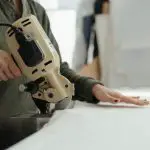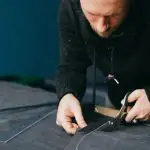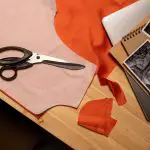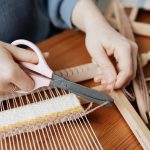If you have ever wondered how the clothes you wear are made, you might have heard about fabric cutters. These skilled professionals play a crucial role in the fashion industry, cutting the fabric into the right shapes and sizes for garments.
As a fabric cutter, you use specialized tools and techniques to ensure that each piece of cloth is cut accurately and efficiently. Fabric cutting is not just about slicing through the material with scissors or a blade. It requires precision, attention to detail, and a deep understanding of the clothing production process.
As a fabric cutter, you work closely with designers, pattern makers, and sewing machine operators to transform raw materials into wearable garments. In this article, we will explore the role of fabric cutters in the fashion industry, the materials they work with, the tools they use, and the importance of accuracy and precision in fabric cutting.
Table of Contents
Overview of the Clothing Production Process
So, you’re getting ready to produce a new clothing line and want to know the basics of the process. Well, let’s start by understanding how fabric cutters play a vital role in bringing your designs to life.
The clothing production process involves several stages, including design, pattern-making, sample-making, grading, and production. Fabric cutters are responsible for cutting the fabric according to the pattern, which is an essential step in the production process. They use a variety of cutting tools, such as scissors, rotary cutters, and electric knives, to ensure that the fabric is cut accurately and efficiently.
Fabric cutters work closely with other members of the production team, such as designers, pattern-makers, and seamstresses, to ensure that the final product meets the desired specifications. They must have a keen eye for detail, as even a small mistake in the fabric cutting process can affect the overall quality of the garment.
In summary, fabric cutters play a vital role in the clothing production process, and their expertise and attention to detail are essential for creating high-quality garments.
The Role of Fabric Cutters in the Fashion Industry
Fabric cutters are essential members of a fashion team, using their expert skills to precisely cut materials for various garments. They play a crucial role in the clothing production process, ensuring that the materials are cut accurately and efficiently.
Here are some key points that highlight the importance of fabric cutters in the fashion industry:
- Fabric cutters use specialized tools and equipment to cut fabrics, leather, and other materials used in clothing manufacturing.
- They work closely with designers and pattern makers to ensure that the materials are cut according to the right specifications, such as size, shape, and grain direction.
- Fabric cutters must have a keen eye for detail and be able to work quickly and accurately to ensure that the materials are cut in a timely manner.
Without fabric cutters, the fashion industry wouldn’t be able to produce the high-quality garments that we all love and enjoy. Their expert skills and precision ensure that the materials are cut to the right size and shape, allowing designers to create beautiful and functional garments that are both fashionable and comfortable.
So, the next time you put on a new outfit, take a moment to appreciate the hard work and dedication of the fabric cutter who helped make it possible.
Types of Materials that Fabric Cutters Work With
You’ll be amazed at the variety of materials that expert fabric cutters work with in the fashion industry. Fabric cutters are responsible for cutting various types of fabrics, from delicate silk to heavy leather. They also cut synthetic materials, cotton, wool, linen, and even denim.
One of the most challenging materials that fabric cutters work with is leather. Cutting leather requires a sharp blade and a steady hand, as it can easily tear or stretch. Leather also varies in thickness, which makes it difficult to cut through evenly. Fabric cutters must be skilled in handling leather to ensure that they get the right shapes and sizes for each garment.
Another material that fabric cutters work with is lace. Lace is a delicate and intricate fabric that requires precision cutting to achieve a perfect shape. Fabric cutters must be careful not to cut too much or too little, as it can affect the overall design and look of the garment. They also need to know how to handle different types of lace, such as Chantilly, Guipure, and Venise, to ensure that they cut it perfectly.
Fabric cutters work with a wide range of materials, from leather to lace, to create high-quality garments. They need to be skilled in handling different types of fabrics to ensure that they get the perfect shapes and sizes for each garment. As a result, fabric cutters play a crucial role in the fashion industry, ensuring that every piece of clothing is made with precision and care.
Tools Used by Fabric Cutters
The tools utilized by fabric cutters are essential in achieving precise and accurate cuts, requiring skilled hands and a keen eye for detail. One of the primary tools fabric cutters use is the rotary cutter, which allows them to cut through multiple layers of fabric at once.
They also use scissors, which come in various sizes and shapes, depending on the fabric being cut. Another important tool in a fabric cutter’s arsenal is the cutting mat. This provides a surface for the fabric to lay on while cutting, and also protects the surface underneath from damage.
The mat is usually made of a self-healing material, which helps to prevent the blade from dulling too quickly. In addition to these tools, fabric cutters also use rulers and measuring tapes to ensure accurate cuts. They may also use a chalk or fabric marker to mark the fabric before cutting, which helps to ensure precise cuts and minimize mistakes.
With the right tools and techniques, fabric cutters can achieve the perfect cuts needed for a wide variety of projects.
Importance of Accuracy and Precision in Fabric Cutting
To achieve the perfect cuts for your sewing projects, it’s crucial to be precise and accurate in your fabric cutting technique. Accuracy and precision are essential in fabric cutting because they ensure that the pieces of fabric are uniform in size. If the pieces are not uniform in size, they won’t fit together correctly, and your project won’t turn out as planned.
Therefore, it’s crucial to measure your fabric carefully and use the appropriate cutting tools to achieve the desired results. Another reason why accuracy and precision are important in fabric cutting is that they can save you time and money. If you make inaccurate cuts, you may end up wasting fabric, which can be costly, especially if you’re working with expensive materials.
Additionally, if your cuts are imprecise, you may spend more time correcting your mistakes, which can be frustrating and time-consuming. By being accurate and precise, you can ensure that you use the right amount of fabric and that your project comes together quickly and efficiently.
Precision and accuracy in fabric cutting can help you improve your sewing skills. When you cut fabric accurately, it’s easier to sew the pieces together, and your finished project will look more professional. Additionally, the more precise you are in your fabric cutting technique, the more confident you’ll become in your overall sewing skills. As a result, you’ll be able to take on more challenging sewing projects and create beautiful, high-quality garments and accessories.
Fabric Cutting Techniques
When it comes to fabric cutting techniques, there are two main approaches you can take: cutting with a pattern or cutting freehand.
If you choose to cut with a pattern, you’ll need to carefully align the pattern pieces on the fabric and cut around them precisely.
On the other hand, cutting freehand requires a steady hand and a good eye for detail, as you’ll need to cut the fabric without a guide.
Cutting with a Pattern
Get ready to cut out your fabric pieces with ease by simply laying your pattern on top and tracing around it with a fabric marker. This is one of the most common and straightforward methods of cutting fabric with a pattern.
Make sure to choose the right size pattern for your project and position it on the fabric carefully to avoid wasting any material.
Once you’ve traced the pattern onto the fabric, use a fabric cutter to cut along the lines. Be sure to keep your hands and the fabric steady while cutting to achieve clean and accurate shapes.
Cutting with a pattern can save time and effort, especially if you’re making several identical pieces. With practice, you can become proficient at this cutting technique and produce stunning pieces with ease.
Cutting Freehand
Cutting freehand can be liberating and creative, allowing you to unleash your inner artist and create unique pieces that truly reflect your personal style. With this method, you don’t need to rely on a pattern to guide you, and you are free to experiment with different shapes and sizes.
Here are some tips to help you make the most out of your freehand cutting:
- Use sharp scissors – This will help you make cleaner cuts and prevent fabric from fraying.
- Start with a rough template – Draw a basic shape onto the fabric with a fabric pen or chalk to guide you as you cut.
- Practice on scrap fabric first – This will help you gain confidence and get a feel for how the fabric behaves when cut.
By following these guidelines, you can create truly unique pieces that are one-of-a-kind and reflect your personal style. So don’t be afraid to let your creativity take over and try cutting freehand!
However, it’s important to keep in mind that cutting freehand can also be more challenging and time-consuming than cutting with a pattern. It requires more precision and attention to detail, and mistakes are harder to fix. So if you’re new to sewing or don’t feel confident in your cutting skills, it may be best to start with a pattern and work your way up to freehand cutting.
With practice and patience, you’ll soon be able to create beautiful pieces that are uniquely yours.
- How Does Ring Spun Cotton Affect Garment Fit and Shape Retention? - August 13, 2024
- What Are the Challenges in Producing Ring Spun Cotton? - August 13, 2024
- Is Ring Spun Cotton Suitable for Plus-Size Clothing? - August 13, 2024






